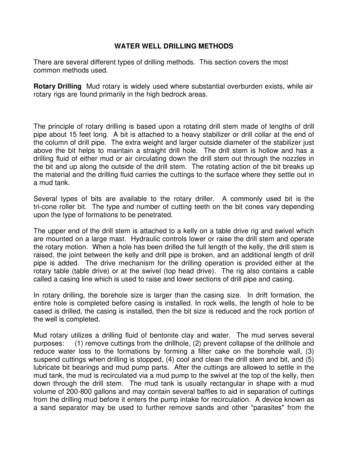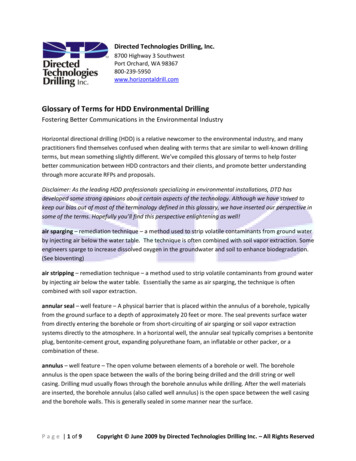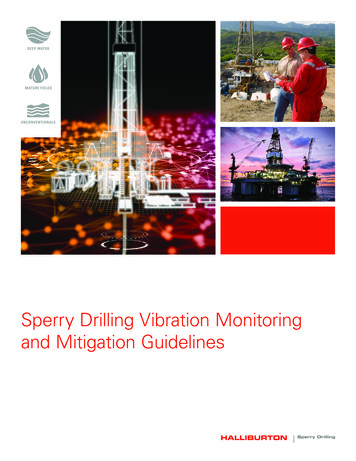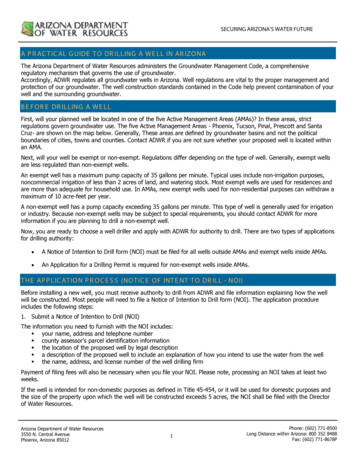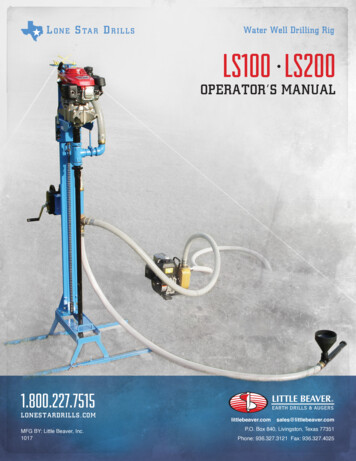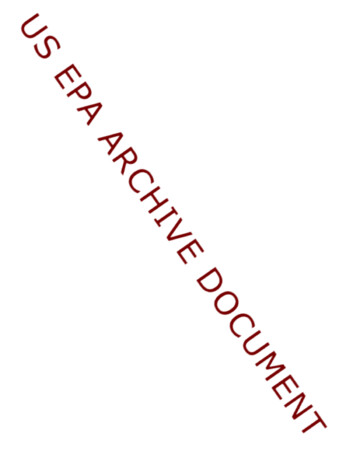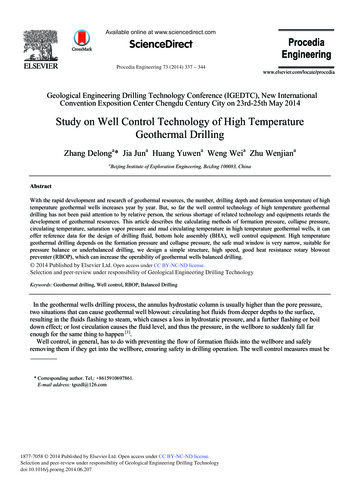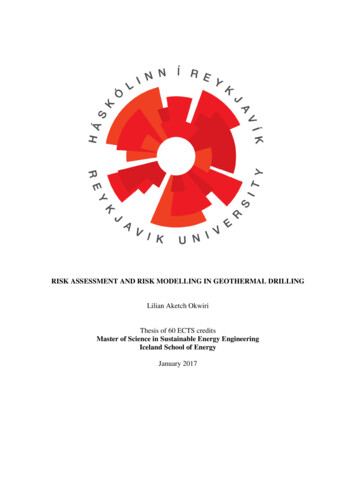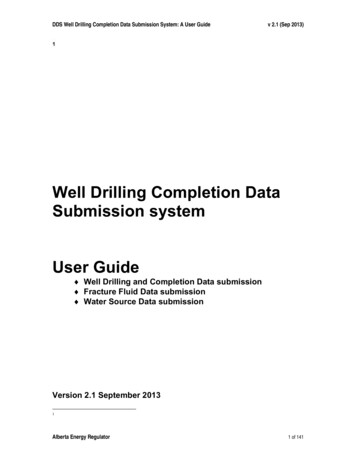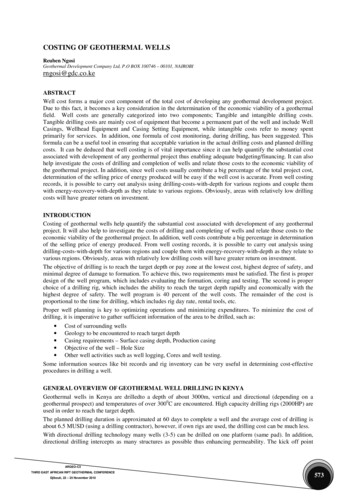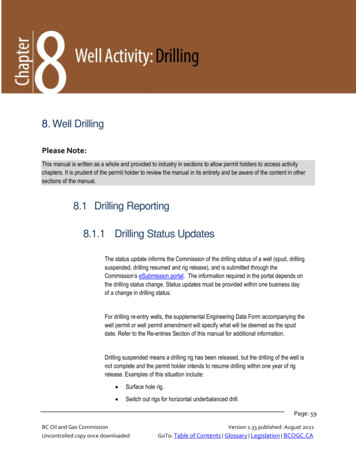
Transcription
Oil and Gas Activity Operations Manual8. Well DrillingPlease Note:This manual is written as a whole and provided to industry in sections to allow permit holders to access activitychapters. It is prudent of the permit holder to review the manual in its entirety and be aware of the content in othersections of the manual.8.1 Drilling Reporting8.1.1 Drilling Status UpdatesThe status update informs the Commission of the drilling status of a well (spud, drillingsuspended, drilling resumed and rig release), and is submitted through theCommission’s eSubmission portal. The information required in the portal depends onthe drilling status change. Status updates must be provided within one business dayof a change in drilling status.For drilling re-entry wells, the supplemental Engineering Data Form accompanying thewell permit or well permit amendment will specify what will be deemed as the spuddate. Refer to the Re-entries Section of this manual for additional information.Drilling suspended means a drilling rig has been released, but the drilling of the well isnot complete and the permit holder intends to resume drilling within one year of rigrelease. Examples of this situation include: Surface hole rig. Switch out rigs for horizontal underbalanced drill.Page: 59BC Oil and Gas CommissionUncontrolled copy once downloadedVersion 1.33 published: August 2021GoTo: Table of Contents Glossary Legislation BCOGC.CA
Oil and Gas Activity Operations Manual Release drilling rig, switch to service rig to penetrate play with air (alsoconsidered a drilling operation). Drilling ceases due to breakup and will resume when access is restored. For a short suspension of drilling operations (for instance, seasonalshutdowns), do not report as drilling suspended. On the Summary Report ofDrilling Operations explain the reason for the short suspension (for example:seasonal/holiday shutdown for five days).Drilling resumed means drilling has resumed after a drilling suspension. The drillingresumed date is usually when the bit commences making new hole.Rig released means the drilling of the well is complete.8.1.2 Incident ReportingIncidents may include, but not limited to; spills, gas release, fire/explosion, kicks ofcertain level, vandalism or threats and major structural failures. Refer to section 8.2.3for more information on kick reporting.All incidents must be reported following the Commission’s Incident ReportingInstructions and Guidelines document.8.1.3 Kick ReportingAll kicks must be reported to the Commission through the eSubmission portal within24 hours of the occurrence. A follow-up update may be required, depending on thewell control situation.If a kick meets any one of the following criteria, it must be reported as an incident(refer to section 8.2.2 for incident reporting): Pit gain of 3 m3 or greater.Casing pressure 85 per cent of maximum allowed casing pressure.50 per cent or more out of hole when kicked.Well taking fluid (lost circulation).Associated spill.Page: 60BC Oil and Gas CommissionUncontrolled copy once downloadedVersion 1.33 published: August 2021GoTo: Table of Contents Glossary Legislation BCOGC.CA
Oil and Gas Activity Operations Manual General situation deterioration, (for example: leaks, equipment failure,unable to circulate, etc.).Deterioration of the well control situation should be reported to a Commission DrillingEngineer. If a Commission Drilling Engineer is unavailable or if after hours, call theCommission 24-hour Incident Reporting Line at 1-800-663-3456.8.1.4 Lost Circulation ReportingWhen the lost volume is equal to or greater than 5 m3 for oil based mud or 10m3 forwater based mud, the lost circulation must be reported through the Commission’seSubmission portal before rig release.8.1.5 Hole Problem ReportingFor fish in hole, sloughing hole, cementing problem, well control issues or other holeproblems where the Commission’s assistance is required, contact a CommissionDrilling Engineer. If a Commission Drilling Engineer is unavailable or if after hours, callthe Commission 24-hour Incident Reporting Line at 1-800-663-3456.8.2 Well Drilling Data Requirements8.2.1 Summary Report of Drilling OperationsThe summary report of drilling operations must be submitted to the Commissionthrough the eSubmission portal within four business days of rig release or drillingsuspended. This includes when the rig is moved or shut down for a period of time, butexcludes shutdowns for rig repairs or seasonal holidays.The Summary Report of Drilling Operations must be completely and accurately filledout. As shown in Table 8A, a summary of formation tops and logs run mustaccompany the online submission of the Summary Report. This summary mustinclude the following:Page: 61BC Oil and Gas CommissionUncontrolled copy once downloadedVersion 1.33 published: August 2021GoTo: Table of Contents Glossary Legislation BCOGC.CA
Oil and Gas Activity Operations Manual A list of formation tops as picked from the logs. If no open hole logs are run,formation tops may be selected from the measurement while drilling gammaray (MWD-Gr) log. If there is no MWD-Gr log, formation tops may beselected based on drill cuttings samples. Measured depth (MD) and true vertical depth (TVD) must be provided if thewell is directional or horizontal. List of logs run (including MWD-Gr) with the following information: Log type run (include MWD-Gr if run). The log type must be writtenout in full - for instance, borehole compensated sonic, not BHC. Run number. Last date run for each run number (finished date). Intervals logged (that is, top depth and bottom depth) for each logincluding measured depth and true vertical depth, as applicable. Bottom hole temperature (BHT) must be included with the writtenlist of logs run.Table 8A Formatting for Summary Report of Drilling OperationsLog Type(Name)Run #Run EndDateTop Depth(MD)BottomDepth(MD)Top Depth(TVD)BottomDepth(TVD)BottomHole Temp(BHT)Submit the full name of the log, no abbreviations.For each log, one line of information must be entered.For wells that have experienced drilling problems not evident from the SummaryReport of Drilling Operations, provide a brief point summary in the comments sectionto explain the problems. For example: Drilled to 800 metres, lost fish in hole. Fish top at 600 metres, fish bottom at 750 metres. Brief description of fish. Address issue of potential interzonal communication (if applicable). Set plug #1. Kicked off plug at depth of 1,215 metres to drill around fish.Page: 62BC Oil and Gas CommissionUncontrolled copy once downloadedVersion 1.33 published: August 2021GoTo: Table of Contents Glossary Legislation BCOGC.CA
Oil and Gas Activity Operations ManualFor drilling re-entries, provide a brief point summary (in the comments section) of theoperations performed if not evident from the Summary Report of Drilling Operations.For example:For a basic squeeze of existing perforations, bridge plug set and mill of window incasing to drill horizontally out of cased vertical well. Started drilling on surface three metre abandonment plug at 0800 hr 200706-15. Cement squeezed existing perforations and pressure tested same. Set bridge plug at 1,800 metres and whipstock and commenced cuttingwindowRefer to the Well Data Submission Requirements Manual for file naming andsubmission requirements.8.2.2 Directional SurveyA wellbore directional survey is required if: Well is horizontally or directionally drilled.Surface location of well is outside target area.Surface location of well is within the target area but closer to the targetboundary than measured depth multiplied by two per cent.Example (for a well with a 250 meters (m) gas target setback):Gas well total measured depth 2,200.0 m.2,200.0 m X 2% 44.0 m.44.0 m 250.0 m 294.0 m.Therefore, if the well surface location is closer than 294 m to the spacingborder, a directional survey must be run.Directional surveys must include: Actual surface coordinates of the wellhead.Page: 63BC Oil and Gas CommissionUncontrolled copy once downloadedVersion 1.33 published: August 2021GoTo: Table of Contents Glossary Legislation BCOGC.CA
Oil and Gas Activity Operations Manual Last point on the directional survey must be the total measured depth (TMD)of the well bore. This allows the Commission to link the directional surveywith the correct drilling event.Cross-section and plan view graphical plots must be included within the PDFfile if available.Directional surveys should be saved and submitted in both TXT and PDF format. TheCommission’s Directional Survey File Format Guide provides detailed informationregarding the submission of directional survey data and the As-Drilled Survey Plan.Deviation SurveysDeviation surveys must be made during drilling at intervals not exceeding 150m indepth, unless there are significant wellbore stability problems, in which case a surveymay be omitted.8.2.3 Drillstem TestingA pressure chart and report containing complete details on fluid recoveries and otherpertinent facts for each drillstem test or wire line test taken on a well must besubmitted to the Commission within 30 days using eSubmission portal within 30 daysof the date on which the test was made.Useful references for drillstem testing include: Worksafe BC’s Drillstem Testing Safety Guidelines for drilling and servicerigs. Covers safe work guidelines, minimum health and operating standardsand personnel qualifications. The ESC’s IRP Volume #4: Well Testing and Fluid Handling.Page: 64BC Oil and Gas CommissionUncontrolled copy once downloadedVersion 1.33 published: August 2021GoTo: Table of Contents Glossary Legislation BCOGC.CA
Oil and Gas Activity Operations Manual8.2.4 Drill Cutting Samples and Core SamplesDrill cutting samples are required at intervals of five metres, beginning at 50 metresmeasured depth above the shallowest potential reservoir zone and continuing to thetotal depth of the well.In accordance with Section 29 of the Drilling and Production Regulation, well samplesand cores must be collected during drilling operations and submitted to theCommission within 14 days of rig release. Refer to the Well Data SubmissionRequirements Manual for further information on related submission process andrequirements.8.2.5 Well LoggingA gamma ray log is required from the ground surface to the total depth of the well.A neutron log is required from 25 metres below ground level to the base of the surfacecasing.Resistivity and porosity logs are required from the base of the surface casing to thetotal depth of the well.Wellbores may penetrate up to 20 metres below the lowest objective formation inorder to fully log the objective formation.If a well is part of a multi well pad, only one well needs to have all the abovementioned logging conducted, however, all wells must have a gamma ray log takenfrom the base of the surface casing to the total depth. This applies for theunconventional zones listed in Schedule 2 of the Drilling and Production Regulation.Page: 65BC Oil and Gas CommissionUncontrolled copy once downloadedVersion 1.33 published: August 2021GoTo: Table of Contents Glossary Legislation BCOGC.CA
Oil and Gas Activity Operations Manual8.2.6 Wellsite Geology ReportWell Site Geology ReportSubmits a well site geology report through the eSubmission portal portal within 60days of rig release. Refer to the Commission’s Well Data Submission RequirementsManual for more information on submission of wellsite geology reports.8.2.7 Logging and Sample WaiverRequests for logging and sample waivers should be made during business hours tothe Commission’s Petroleum Geology, Resource Stewardship & Major Projects. Therequest should be submitted to a geologist by email, clearly stating the request andthe reason for the request (for example, hole conditions). Refer to the Commissionphone list on the website and Petroleum Geology, Resource Stewardship and MajorProjects for Contact information. After business hours, the Commission’s 24-hourphone line in Fort St. John is 250-794-5200.8.2.8 Flaring During DrillingIf flaring during drilling operations is necessary, note the following: A Notice of Flare must be submitted using the eSubmission Portal forunderbalanced drilling. The total flared volume must be reported via Petrinex,in accordance with the usual production volume reporting timeline. Inaddition, a Well Deliverability Test Report must be submitted through theeSubmission Portal within 60 days. For other operations (drillstem testing, managed pressure drilling, kickflaring) advance notification is not required and flared volumes must bereported on the Summary Report of Drilling Operations. Estimation is permitted for operations such as kick flaring where accuratemeasurement of flared volumes is not possible.To discharge air contaminants pursuant to Section 6(1)(d) of the Oil and Gas WasteRegulation, the permit holder must, at least 15 days prior to commencement of welltest flare or incineration of sour gas containing 5 mole per cent H2S, in accordancewith Section 8 of that regulation, submit dispersion modelling and details of the wellPage: 66BC Oil and Gas CommissionUncontrolled copy once downloadedVersion 1.33 published: August 2021GoTo: Table of Contents Glossary Legislation BCOGC.CA
Oil and Gas Activity Operations Manualtest to the satisfaction of the Commission. Submissions must be provided toOGCWaste.Management@bcogc.ca.8.2.9 As Drilled Wellsite Survey PlanSection 35(1) of the Drilling and Production Regulation requires the submission of anAs-Drilled Survey Plan within 14 days of rig release. The survey plan must be in itsoriginal size from the Surveyor (for example, 22” x 34”) as a PDF, and show andclearly identify the following information: ·Surface and bottom hole location of all drilling events associated withthe well · ·North and East offsets to the nearest corner of the spacing unit, andthe reference cornerNorthing and Easting coordinates, determined using NAD 838.2.10 Well Drilling Site Clean Up (WasteManagement)Permit holders must clean up the well drilling site and restore the surface upon drillingcompletion and submit a Well Site Clean Up Form and Drilling Waste Report whereapplicable and detailed in this section. Refer to the Drilling Waste ManagementChapter of the oil and gas handbook for more information on drilling wastemanagement.Well Site Clean Up FormA Well Site Cleanup Form is required after a well as been drilled to report and informthe Commission of well site and waste management activities.A Well Site Clean Up Form should include the well name and number, well site sketchdrawings and if available, photographs of disturbed areas. Detailed requirements areincluded on the form. The Commission’s Well Site Clean Up Form is available as aword document, downloaded online from the Commission’s website. Once completed,the form is mailed to the Commission address as indicated on the form within 60 daysof rig release.Page: 67BC Oil and Gas CommissionUncontrolled copy once downloadedVersion 1.33 published: August 2021GoTo: Table of Contents Glossary Legislation BCOGC.CA
Oil and Gas Activity Operations ManualDrilling Waste Disposal ReportThe Drilling Waste Disposal Summary form should include the permit number,sketches, laboratory results and field analysis and, if available, photographs. Detailedrequirements are included in the form. The Drilling Waste Disposal Summary form issubmitted using the Commission’s eSubmission portal within 90 days of the closing ofany earthen pit used to store drilling waste.8.3 Blowout Prevention: Practices and ProceduresThe following section outlines blowout prevention standards that a permit holder should followto comply with the requirements of Part 4, Division 2 of the Drilling and Production Regulation.It is the responsibility of the permit holder to ensure that blowout prevention equipment andprocedures are adequate.A permit holder may use alternate blowout prevention equipment and techniques if they candemonstrate by means of a detailed engineering analysis that the alternate equipment ortechniques are adequate as required by Section 16(1) of the Drilling and ProductionRegulation. This engineering analysis should be submitted as part of the well permitapplication.Recommended and industry accepted blowout prevention (BOP) guidelines are included in thissection. BOP stack schematics are in Appendix A of this manual.If an operation is not covered in these guidelines, refer to the applicable industry recommendedpractices (for example, Energy Safe Canada (ESC) IRPs at www.energysafetycanada.com).Exercise caution when drilling surface holes.It is prudent to utilize divertors in areas where shallow gas has been encountered or in wildcatareas (areas where little is known with certainty about the subsurface geology) as furtherexplained in Appendix C of this manual.Page: 68BC Oil and Gas CommissionUncontrolled copy once downloadedVersion 1.33 published: August 2021GoTo: Table of Contents Glossary Legislation BCOGC.CA
Oil and Gas Activity Operations Manual8.3.1 Blowout Prevention ClassificationsBlowout prevention equipment is classified as follows:1. Class A: to be used from the depth of the surface casing to 1,800 metres truevertical depth.2. Class B: to be used from a depth of 1,800 metres to 3,000 metres truevertical depth.3. Class C: to be used from a depth of 3,000 metres to 5,500 metres truevertical depth.4. Class D: to be used from a depth of 5,500 metres true vertical depth andgreater.8.3.2 Blowout Prevention Pressure RatingsThe minimum pressure rating of blowout prevention equipment must be:1. 14,000 kPa for Class A equipment.2. 21,000 kPa for Class B equipment.3. 34,000 kPa for Class C equipment.4. 70,000 kPa for Class D equipment.8.3.3 Other Blowout Prevention StipulationsWhen a well is being drilled, blowout prevention equipment must, at all times:1. Consist of a minimum of one annular preventer and two or more rampreventers; the ram preventers are to be comprised of a blank ram and oneor more rams to close off around drill pipe, tubing or casing being used in thewell.2. Be connected to a casing bowl that is equipped with:3. An upper flange that is an integral part of the casing bowl.Page: 69BC Oil and Gas CommissionUncontrolled copy once downloadedVersion 1.33 published: August 2021GoTo: Table of Contents Glossary Legislation BCOGC.CA
Oil and Gas Activity Operations Manual4. For blowout prevention Class A and B, at least one threaded, flanged orstudded side outlet with one valve.5. For blowout prevention Class C and D, two flanged or studded side outletswith two valves.6. Include steel lines or adequate high pressure hoses connected to theblowout preventer assembly, one or more for bleeding off pressure and oneor more for killing the well.7. Consist of components having a working pressure equal to that of theblowout preventers, except that part of the bleed-off line or lines locateddownstream from the last control valve on the choke manifold.8. Have the valve hand wheel assembly in place and securely attached to thevalve stem on all valves in the blowout prevention system.9. Be maintained so that its operation will not be impaired by adverse weatherconditions.10. Hammer unions should not be used in the manifold shack or under thesubstructure on the primary well control system but can be used inUBD/MPD pressure/flow control system providing the hammer union endconnection is welded to the pipe.11. Conform to the specifications set out in Appendix B.8.3.4 Blowout Prevention ControlsIf hydraulically operated blowout preventers are installed, a clearly marked operatingcontrol indicating direction of closure for the annular blowout preventer must belocated at least 15 metres from the well.The control valve regulating the closure of the annular preventer must be free of anyvalve locking device.All manual controls for the locking of manual ram type blowout preventers must beinstalled or readily accessible.If ram type blowout preventers are used at a cased well, the controls must beattached and be at least five metres from the well.Page: 70BC Oil and Gas CommissionUncontrolled copy once downloadedVersion 1.33 published: August 2021GoTo: Table of Contents Glossary Legislation BCOGC.CA
Oil and Gas Activity Operations ManualAll blowout preventers must be hydraulically operated and connected to anaccumulator system.8.3.5 Blowout Prevention Ancillary EquipmentBleed Off LinesThe bleed off lines referred to above must be:1. A minimum nominal 76 millimetre diameter of uniform bore.2. Connected only by welded neck flanges that are perpendicular to theline to which they are attached.3. Equipped with a gauge connection where well pressures may bemeasured.4. Connected to a choke manifold and a mud tank through a mud gasseparator.5. Securely held down and terminated in a slightly downward direction intoan earthen pit or flare tank, if the lines are downstream of the chokemanifold.Choke ManifoldThe choke manifold referred to above must be located:1. A minimum distance of 15 metres from the well bore.2. A satisfactory distance from the substructure and the mud tanks suchthat during well control operations personnel are not exposed tohazardous gases which may be present in those locations.The choke manifold referred to above must be designed:1. To conform with Class A, B, C or D equipment.2. To permit the flow to be directed through a full opening line or througheither of the two lines, each containing an adjustable choke.3. Equipped with accurate metric pressure gauges to provide drill pipe andcasing pressures at the choke manifold once the surface casing iscemented in place.4. Enclosed by a suitable housing, with adequate heat to prevent freezing.Page: 71BC Oil and Gas CommissionUncontrolled copy once downloadedVersion 1.33 published: August 2021GoTo: Table of Contents Glossary Legislation BCOGC.CA
Oil and Gas Activity Operations Manual5. Securely tied down and containing only pipe that is straight or with a1.57 radian bends (90º) and which is constructed of flanged, studded orwelded tees, blank flanged or ball plugged on fluid turns in addition tohaving bleed off lines.6. Hammer unions must not be used on main flow lines in the enclosurethat houses the choke manifold.AccumulatorThe accumulator system must be:1. Installed and operated in accordance with the manufacturer'sspecifications.2. Connected to the blowout preventers, with lines of equivalent workingpressure to the system, and within 5 metres of the well - the lines mustbe of steel construction unless completely sheathed with adequate fireresistant sleeving.3. Capable of providing, without recharging, fluid of sufficient volume andpressure to close the annular preventer, close a ram preventer, open thehydraulically operated valve and retain a pressure of 8,400 kPa on theaccumulator system.4. Recharged, within five minutes, by a pressure controlled pump capableof recovering the accumulator pressure drop resulting from closing theannular preventer, closing a ram preventer or opening the hydraulicallyoperated valve.5. Capable of closing any ram type preventer within 30 seconds.6. Capable of closing the annular preventer within 60 seconds.7. Equipped with readily accessible fittings and gauges to determine theprecharge pressure of each nitrogen container.If nitrogen cylinders are used as an emergency pressure source, sufficient usablenitrogen must be available at a minimum pressure of 8,400 kPa to fully close theannular preventer and pipe rams and open the hydraulically operated valve.Mud Tank Fluid Volume Monitoring SystemsA mud tank fluid volume monitoring system (e.g., Pit Volume Totalizer) must beused during drilling.Page: 72BC Oil and Gas CommissionUncontrolled copy once downloadedVersion 1.33 published: August 2021GoTo: Table of Contents Glossary Legislation BCOGC.CA
Oil and Gas Activity Operations ManualThe monitoring system must be sufficiently precise to detect a change of 1 m3in total pit volume. This typically means each active compartment must have aprobe installed.A drilling fluid level monitoring station with an alarm system must be located at ornear the driller’s position.The alarm must include a visual indicator which comes on automaticallywhenever the alarm is shut off. The indicator must effectively alert the drillers onthe floor and in the doghouse (e.g. a highly visible flashing light).Mud tank volumes must be continuously recorded in the Electronic DrillingRecorder.A flow line sensor is another monitoring device that can be used in conjunctionwith an automated mud tank volume monitoring system. The flow line flow sensorcannot be used alone as a monitoring device, but can be installed to augment theautomated mud tank volume monitoring system.Trip TanksThe drilling mud system must be equipped with a trip tank with the capacity of 5cubic metres to accurately measure the fluid required to fill the hole while pullingpipe from the well and the trip tank must: Be constructed so that the cumulative volume can be reliably andrepeatedly read to an accuracy of 0.15 m3 (150 litres) from the driller'sposition. Be tied into the mud return line. Be equipped so that drilling fluid can be transferred into and out of thetrip tank. Be located in or within 10 metres of the shale shaker end of the mudtank and be readily accessible to afford visual observance of the fluidlevel.A diagram of the trip tank and the trip tank volume indicator must be prominentlydisplayed in the control centre (also known as the dog house).The trip tank volume indicator must specify the trip tank volume and each volumegraduation on the scale.Page: 73BC Oil and Gas CommissionUncontrolled copy once downloadedVersion 1.33 published: August 2021GoTo: Table of Contents Glossary Legislation BCOGC.CA
Oil and Gas Activity Operations ManualMud-Gas SeparatorMud gas separators must:1. Be designed to ensure personnel safety and adequate mud gasseparation.2. Be connected to a securely fastened inlet line and outlet line and theoutlet line must:3. Be at least one size larger than the inlet line.4. Terminate preferably in a flare tank, but also may terminate in anearthen flare pit, at least 50 metres from the well.Kelly Cock and Stabbing ValveAt all times when a well is being drilled:1. A valve must be installed in the kelly assembly.2. A full opening stabbing valve that can be connected to the drill pipe, drillcollars or tubing in the well and a device capable of stopping anybackflow up the drill string must be provided and must:1. Be equipped with removable handles to facilitate handling by twopersons.2. Be stored in the control centre (dog house) or another satisfactorylocation where it is readily available for use with the valve in theopen position.3. Have the valve closing handle attached to the valve holdingstand.Flare TanksFlare tanks must:1. Be constructed of steel with walls of sufficient height to ensure liquidcontainment during prolonged exposure to fluid flow and extreme heat.2. Have structural integrity.3. Have an impingement plate to resist erosion from high-velocity gas,liquids and solids positioned on the flare tank wall directly opposite allflare lines and diverter lines connected to the flare tank.4. Have a minimum capacity of 8 cubic metres and be appropriately sizedfor the flow to avoid creating backpressure.5. Not be covered.Page: 74BC Oil and Gas CommissionUncontrolled copy once downloadedVersion 1.33 published: August 2021GoTo: Table of Contents Glossary Legislation BCOGC.CA
Oil and Gas Activity Operations Manual6. Be positioned a minimum distance of 50 metres from the well.7. Be equipped with a minimum 50.8 mm liquid loading steel line that isconnected at all times for the purpose of drawing fluids from the tank,with the connection point of the loading line a minimum of 9 metres fromthe flare tank.8. Have degasser vent lines kept separated from the liquid in the flare tank.The vent lines may be laid on the ground next to the flare tank, providedno fire hazard exists.9. Have a minimum 10 metre setback from vegetation or other potential firehazards.Flare PitsThe earthen pit referred to in this document must:1. Be excavated to a minimum depth of 2 metres.2. Have side and back walls rising not less than 2 metres above groundlevel.3. Be constructed to resist the erosion of a high pressure flow of gas orliquid.4. Be constructed to contain any liquid.5. Be used for emergency purposes only.8.3.6 Testing of Blowout Prevention EquipmentBlowout equipment must be shop serviced and shop tested to its workingpressure at least once every three years and test data and maintenanceperformed must be recorded and made available on request from a Commissionofficial.Following assembly, all flow line connections that form a part of the blowoutprevention system must be inspected by the rig manager and recorded in thedaily report.Prior to drilling out cement from any string of casing, each unit of the blowoutprevention equipment must be pressure tested, first to a low pressure of 1,400kPa and then to a high pressure tests described as follows:Prior to drilling out surface casing:Page: 75BC Oil and Gas CommissionUncontrolled copy once downloadedVersion 1.33 published: August 2021GoTo: Table of Contents Glossary Legislation BCOGC.CA
Oil and Gas Activity Operations Manual1. Each ram preventer to the lesser of the maximum potential shut inpressure (if known), or required BOP Class.2. Test the annular to the lesser of 70% of the recommended workingpressure, recommended working pressure of the wellhead or the rampressure test as per API 53 or as per the manufacturer’s recommendedpractice.Prior to drilling out subsequent casing string:1. Each ram preventer to the lesser of the maximum potential shut inpressure (if known), or required BOP Class.2. Test the annular to the lesser of 70% of the recommend
Drilling Operations explain the reason for the short suspension (for example: seasonal/holiday shutdown for five days). Drilling resumed means drilling has resumed after a drilling suspension. The drilling resumed date is usually when the bit commences making new hole. Rig released means the drilling of the well is complete. 8.1.2 Incident .
